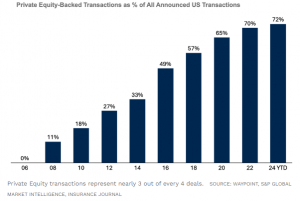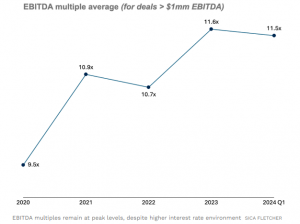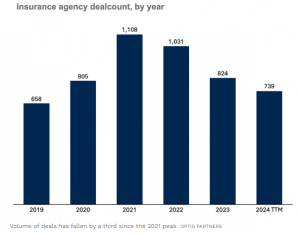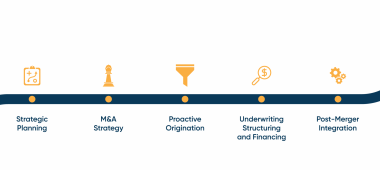This article was originally published in Forbes.
For nearly two decades, private equity (PE) has been a transformative force in the insurance agency sector, driving consolidation and increasing valuations. Currently, 72% of all agency transactions involve private equity buyers. With over 50 active consolidators currently vying for acquisitions, the intense competition is resulting in frothy valuations. It’s no coincidence that multiples increased by more than 50% since the arrival of PE.

When discussing PE activity within the insurance industry, it’s important to distinguish between insurance carriers and agencies or brokerages. PE has shown little interest in carriers, which are more capital-intensive and exposed to underwriting risk. In contrast, insurance agencies—businesses that represent clients in the process of finding the best insurance coverage at competitive rates—and wholesalers (MGAs) have become prime targets for investment.
But why? To understand this trend, we must first understand how private equity operates and why insurance agencies fit neatly into their investment playbook.
What is Private Equity?
Private equity firms invest in private companies with the goal of generating outsized returns. Today, U.S. PE firms sit on nearly $1 trillion in “dry powder,” or money waiting to be invested. These firms are under pressure to invest, as they risk losing it if they don’t use it.
Most PE firms pursue a consolidation or rollup strategy. This involves using a platform company to buy and integrate smaller add-on acquisitions to quickly achieve scale. Given their short holding periods, when a PE is trying to grow their portfolio companies, they generally prefer to acquire proven preexisting companies rather than launching new locations themselves. The consolidated entity’s goal is to capture the spread between the higher valuation multiples that larger businesses command and the lower multiples paid for the smaller firms.
Why Insurance Agencies Are Compelling to PE?
PE typically looks for certain fact patterns, highly prioritizing opportunities with stable cash flows, which provide lenders comfort. Insurance agencies are good candidates for several reasons:
- Recurring, Sticky Revenue: The majority of an agency’s revenue—often 90%+—renews annually. Moreover, agencies tend to be recession-resistant, as businesses and individuals generally must maintain insurance coverage, regardless of broader economic conditions.
- Premium Growth: Because agencies earn commissions based upon a percentage of the policy cost, rising premiums translate directly into higher revenue. Since Covid, insurance premiums have been growing annually by nearly 10%, far in excess of inflation.
- Rising Commission Percentages: Unlike prior challenging insurance markets, underwriters are sharing more favorable commission percentages with agencies, creating an additional revenue tailwind.
- Fragmented Market: Private equity rollups are most effective in fragmented industries—like the insurance agency sector—where no single player holds a dominant market share. The top four agencies in the U.S. control only about 10% of the market, leaving ample room for consolidation.
- Asset-Light, Scalable Operations: Insurance agencies don’t require a lot of capital. Adding new producers has a relatively low incremental cost, allowing agencies to scale efficiently. Combining agencies can also reduce costs by eliminating redundant back-office operations and by having the scale to deal directly with carriers versus Managing General Agents (MGAs).
What Buyers Favor
Having engaged and negotiated with dozens of insurance agency buyers, I’ve observed certain consistent preferences:
- Strong preference for diverse revenue streams, with no single producer generating a disproportionate amount of business. Similarly, lack of concentration across clients, industries, geographies, and lines are also viewed positively.
- Not all revenue is created equal. The most desirable lines of business are those with indefinite recurring revenue. In contrast, one-time or heavily front-loaded sales, such as builder’s risk insurance or life insurance are less marketable and result in lower valuations. Similarly, contingent payments are naturally viewed with skepticism.
- Organic growth through new accounts or expanded coverage amongst existing clients is more valuable than growth resulting from premium inflation.
- A young, hungry team is viewed as a valuable asset, as PE prefers sellers who are motivated to continue growing the business aggressively, rather than retiring.
- A strong reputation within their target markets is vital and is best demonstrated by a low client churn rate. Conversely, a history of lawsuits or Error & Omissions (E&O) claims can be a red flag that scares prospective buyers.
- Nearly all buyers require agencies to own their “book of business” to get credit for the corresponding revenues in their valuation—meaning producers are contractually restricted from taking clients with them if they leave.
Why The Time is Now?
Valuations remain elevated relative to historical levels, even in the face of higher interest rates. This defies conventional wisdom, as rising rates generally reduce affordability and put pressure on PE’s ability to generate the returns that their investors expect. The spread between borrowing rates and expected returns has indeed narrowed, and in some cases has gone negative. Motivated to deploy their dry powder, buyers are using creative approaches to continue to offer high valuations. For example, buyers are using more complex capital structures and have been reducing the percentage of upfront cash.

Deal volumes have cooled from their 2021-2022 peak, as buyers become more selective (note, if this past year involved a more average set of businesses, the corresponding multiple would have been lower). Notably, the majority of the decline is coming from PE buyers. Some of the most aggressive consolidators, like PCF Insurance Services, have slowed their pace dramatically, completing 83 deals in 2022 versus just seven transactions in 2023. These factors in aggregate indicate a market that is likely nearing a saturation point. Given the underlying dynamics, the risk is asymmetric—there is a far greater likelihood of prices further declining than increasing.

Prior acquisitions used high levels of floating rate debt to afford elevated multiples. The higher interest rates have placed pressure on profitability. Furthermore, insurance premiums are cyclical and will likely decline at some point, adding another layer of risk for potential buyers.
Like many trends in M&A, this wave will not last forever. Market sentiment plays a significant role, and a major failure in the industry can quickly shift the landscape. PE investors are herd animals, moving together in unison. If there’s concern that the pool of future buyers might shrink, they become more cautious and refocus their attention on other more promising industries. Once the tide goes out, it can take decades for similar valuation and volume levels to return. For agency owners considering a sale, now is likely the optimal time to capitalize on these favorable conditions—or be prepared to patiently wait for the next market cycle.
Special thanks to Ari Shedlock in help writing this article.













